Assessment of the Thermodynamic and Numerical Modeling of LES of Multi-Component Jet Mixing at High Pressure
Abstract
1. Introduction
2. Mathematical and Physical Model
2.1. Governing Equations
2.2. Thermodynamic Model
2.2.1. Generalized Cubic Equation of State
2.2.2. Multi-Component Modeling
2.3. Transport Properties Viscosity and Heat Conductivity with the Chung Correlations
2.4. Numerical Method and Flow Solver
2.5. Sub-Grid Scale Modeling
3. Considered Configurations and Numerical Setup
4. Results
4.1. Thermodynamic Modeling
4.2. Single-Phase Jet Mixing
4.3. Validation with Experimental Data
4.4. Effect of the Sub-Grid Scale Model
4.5. Detailed Analysis of LES Results
5. Conclusions and Outlook
Author Contributions
Funding
Institutional Review Board Statement
Informed Consent Statement
Data Availability Statement
Acknowledgments
Conflicts of Interest
Abbreviations
| ALDM | Adaptive Local Deconvolution Method |
| EoS | Equation of state |
| LES | Large-eddy simulations |
| PR | Peng-Robinson |
| SoS | Speed of Sound |
| WALE | Wall-Adapting Local Eddy-viscosity |
References
- Anitescu, G.; Tavlarides, L.L.; Geana, D. Phase transitions and thermal behavior of fuel- diluent mixtures. Energy Fuels 2009, 23, 3068–3077. [Google Scholar] [CrossRef]
- De Boer, C.; Bonar, G.; Sasaki, S.; Shetty, S. Application of Supercritical Gasoline Injection to a Direct Injection Spark Ignition Engine for Particulate Reduction; Technical Report No. 2013-01-0257, SAE Technical Paper; SAE: Warrendale, PA, USA, 2013. [Google Scholar]
- Chehroudi, B. Recent experimental efforts on high-pressure supercritical injection for liquid rockets and their implications. Int. J. Aerosp. Eng. 2012, 2012, 121802. [Google Scholar] [CrossRef]
- Mayer, W.; Telaar, J.; Branam, R.; Schneider, G.; Hussong, J. Raman measurements of cryogenic injection at supercritical pressure. Heat Mass Transf. 2003, 39, 709–719. [Google Scholar] [CrossRef]
- Oschwald, M.; Smith, J.; Branam, R.; Hussong, J.; Schik, A.; Chehroudi, B.; Talley, D. Injection of fluids into supercritical environments. Combust. Sci. Technol. 2006, 178, 49–100. [Google Scholar] [CrossRef]
- Klima, T.C.; Peter, A.; Riess, S.; Wensing, M.; Braeuer, A.S. Quantification of mixture composition, liquid-phase fraction and-temperature in transcritical sprays. J. Supercrit. Fluids 2020, 159, 104777. [Google Scholar] [CrossRef]
- Roy, A.; Segal, C. Experimental study of fluid jet mixing at supercritical conditions. J. Propuls. Power 2010, 26, 1205–1211. [Google Scholar] [CrossRef]
- Roy, A.; Joly, C.; Segal, C. Disintegrating supercritical jets in a subcritical environment. J. Fluid Mech. 2013, 717, 193–202. [Google Scholar] [CrossRef]
- Steinhausen, C.; Gerber, V.; Preusche, A.; Weigand, B.; Dreizler, A.; Lamanna, G. On the potential and challenges of laser-induced thermal acoustics for experimental investigation of macroscopic fluid phenomena. Exp. Fluids 2021, 62, 1–16. [Google Scholar] [CrossRef]
- Baab, S.; Steinhausen, C.; Lamanna, G.; Weigand, B.; Förster, F. A quantitative speed of sound database for multi-component jet mixing at high pressure. Fuel 2018, 233, 918–925. [Google Scholar] [CrossRef]
- Qiu, L.; Reitz, R.D. Simulation of supercritical fuel injection with condensation. Int. J. Heat Mass Transf. 2014, 79, 1070–1086. [Google Scholar] [CrossRef]
- Traxinger, C. Real-Gas Effects and Single-Phase Instabilities during Injection, Mixing and Combustion under High-Pressure Conditions. Ph.D. Thesis, Bundeswehr University Munich, Munich, Germany, 2021. [Google Scholar]
- Fathi, M.; Hickel, S.; Roekaerts, D. Large eddy simulations of reacting and non-reacting transcritical fuel sprays using multiphase thermodynamics. Phys. Fluids 2022, 34, 085131. [Google Scholar] [CrossRef]
- Traxinger, C.; Mueller, H.; Pfitzner, M.; Baab, S.; Lamanna, G.; Weigand, B.; Matheis, J.; Stemmer, C.; Adams, N.A.; Hickel, S. Experimental and numerical investigation of phase separation due to multicomponent mixing at high-pressure conditions. In Proceedings of the 28th Conference on Liquid Atomization and Spray System, Chicago, IL, USA, 22–26 July 2018. [Google Scholar]
- Matheis, J.; Hickel, S. Multi-component vapor-liquid equilibrium model for LES of high-pressure fuel injection and application to ECN Spray A. Int. J. Multiph. Flow 2018, 99, 294–311. [Google Scholar] [CrossRef]
- Müller, H.; Pfitzner, M.; Matheis, J.; Hickel, S. Large-eddy simulation of coaxial LN2/GH2 injection at trans-and supercritical conditions. J. Propuls. Power 2016, 32, 46–56. [Google Scholar] [CrossRef]
- Matheis, J.; Müller, H.; Lenz, C.; Pfitzner, M.; Hickel, S. Volume translation methods for real-gas computational fluid dynamics simulations. J. Supercrit. Fluids 2016, 107, 422–432. [Google Scholar] [CrossRef]
- Lapenna, P.E.; Creta, F. Mixing under transcritical conditions: An a-priori study using direct numerical simulation. J. Supercrit. Fluids 2017, 128, 263–278. [Google Scholar] [CrossRef]
- Lapenna, P.; Creta, F. Direct numerical simulation of transcritical jets at moderate reynolds number. AIAA J. 2019, 57, 2254–2263. [Google Scholar] [CrossRef]
- Sharan, N.; Bellan, J. Investigation of high-pressure turbulent jets using direct numerical simulation. J. Fluid Mech. 2021, 922, A24. [Google Scholar] [CrossRef]
- Sou, A.; Hosokawa, S.; Tomiyama, A. Effects of cavitation in a nozzle on liquid jet atomization. Int. J. Heat Mass Transf. 2007, 50, 3575–3582. [Google Scholar] [CrossRef]
- Sou, A.; Biçer, B.; Tomiyama, A. Numerical simulation of incipient cavitation flow in a nozzle of fuel injector. Comput. Fluids 2014, 103, 42–48. [Google Scholar] [CrossRef]
- Örley, F.; Trummler, T.; Hickel, S.; Mihatsch, M.; Schmidt, S.; Adams, N. Large-eddy simulation of cavitating nozzle flow and primary jet break-up. Phys. Fluids 2015, 27, 086101. [Google Scholar] [CrossRef]
- Trummler, T.; Rahn, D.; Schmidt, S.J.; Adams, N.A. Large eddy simulations of cavitating flow in a step nozzle with injection into gas. At. Sprays 2018, 28, 931–955. [Google Scholar] [CrossRef]
- Koukouvinis, P.; Vidal-Roncero, A.; Rodriguez, C.; Gavaises, M.; Pickett, L. High pressure/high temperature multiphase simulations of dodecane injection to nitrogen: Application on ECN Spray-A. Fuel 2020, 275, 117871. [Google Scholar] [CrossRef]
- Müller, H.; Niedermeier, C.A.; Matheis, J.; Pfitzner, M.; Hickel, S. Large-eddy simulation of nitrogen injection at trans- and supercritical conditions. Phys. Fluids 2016, 28, 015102. [Google Scholar] [CrossRef]
- Jafari, S.; Gaballa, H.; Habchi, C.; De Hemptinne, J.C.; Mougin, P. Exploring the interaction between phase separation and turbulent fluid dynamics in multi-species supercritical jets using a tabulated real-fluid model. J. Supercrit. Fluids 2022, 184, 105557. [Google Scholar] [CrossRef]
- Klein, M.; Sadiki, A.; Janicka, J. A digital filter based generation of inflow data for spatially developing direct numerical or large eddy simulations. J. Comput. Phys. 2003, 186, 652–665. [Google Scholar] [CrossRef]
- Selle, L.C.; Okong’o, N.A.; Bellan, J.; Harstad, K.G. Modelling of subgrid-scale phenomena in supercritical transitional mixing layers: An a priori study. J. Fluid Mech. 2007, 593, 57–91. [Google Scholar] [CrossRef]
- Petit, X.; Ribert, G.; Lartigue, G.; Domingo, P. Large-eddy simulation of supercritical fluid injection. J. Supercrit. Fluids 2013, 84, 61–73. [Google Scholar] [CrossRef]
- Haidn, O.; Habiballah, M. Research on high pressure cryogenic combustion. Aerosp. Sci. Technol. 2003, 7, 473–491. [Google Scholar] [CrossRef]
- Habiballah, M.; Orain, M.; Grisch, F.; Vingert, L.; Gicquel, P. Experimental studies of high-pressure cryogenic flames on the Mascotte facility. Combust. Sci. Technol. 2006, 178, 101–128. [Google Scholar] [CrossRef]
- Zong, N.; Meng, H.; Hsieh, S.Y.; Yang, V. A numerical study of cryogenic fluid injection and mixing under supercritical conditions. Phys. Fluids 2004, 16, 4248–4261. [Google Scholar] [CrossRef]
- Kim, T.; Kim, Y.; Kim, S.K. Numerical study of cryogenic liquid nitrogen jets at supercritical pressures. J. Supercrit. Fluids 2011, 56, 152–163. [Google Scholar] [CrossRef]
- Park, T.S. LES and RANS simulations of cryogenic liquid nitrogen jets. J. Supercrit. Fluids 2012, 72, 232–247. [Google Scholar] [CrossRef]
- Lagarza-Cortés, C.; Ramírez-Cruz, J.; Salinas-Vázquez, M.; Vicente-Rodríguez, W.; Cubos-Ramírez, J.M. Large-eddy simulation of transcritical and supercritical jets immersed in a quiescent environment. Phys. Fluids 2019, 31, 025104. [Google Scholar] [CrossRef]
- Poblador-Ibanez, J.; Sirignano, W.A. A volume-of-fluid method for variable-density, two-phase flows at supercritical pressure. Phys. Fluids 2022, 34, 053321. [Google Scholar] [CrossRef]
- Chung, T.H.; Ajlan, M.; Lee, L.L.; Starling, K.E. Generalized multiparameter correlation for nonpolar and polar fluid transport properties. Ind. Eng. Chem. Res. 1988, 27, 671–679. [Google Scholar] [CrossRef]
- Matheis, J. Numerical Simulation of Fuel Injection and Turbulent Mixing Under High-Pressure Conditions. Ph.D. Thesis, Technical University Munich, Munich, Germany, 2018. [Google Scholar]
- Doehring, A.; Kaller, T.; Schmidt, S.J.; Adams, N.A. Large-eddy simulation of turbulent channel flow at transcritical states. Int. J. Heat Fluid Flow 2021, 89, 108781. [Google Scholar] [CrossRef]
- Reid, R.C.; Prausnitz, J.M.; Poling, B.E. The Properties of Gases and Liquids; McGraw Hill Book Co.: New York, NY, USA, 1987. [Google Scholar]
- Miller, R.S.; Harstad, K.G.; Bellan, J. Direct numerical simulations of supercritical fluid mixing layers applied to heptane–nitrogen. J. Fluid Mech. 2001, 436, 1–39. [Google Scholar] [CrossRef]
- Matheis, J.; Hickel, S. Multi-component vapor-liquid equilibrium model for LES and application to ECN Spray A. In Proceedings Stanford Summer School; Center for Turbulence Research: Stanford, CA, USA, 2016. [Google Scholar]
- Banuti, D.T.; Hannemann, K. The absence of a dense potential core in supercritical injection: A thermal break-up mechanism. Phys. Fluids 2016, 28, 035103. [Google Scholar] [CrossRef]
- Terashima, H.; Koshi, M. Unique characteristics of cryogenic nitrogen jets under supercritical pressures. J. Propuls. Power 2013, 29, 1328–1336. [Google Scholar] [CrossRef]
- Schmitt, T.; Selle, L.; Ruiz, A.; Cuenot, B. Large-eddy simulation of supercritical-pressure round jets. AIAA J. 2010, 48, 2133–2144. [Google Scholar] [CrossRef]
- Jafari, S.; Gaballa, H.; Habchi, C.; de Hemptinne, J.C. Towards Understanding the Structure of Subcritical and Transcritical Liquid–Gas Interfaces Using a Tabulated Real Fluid Modeling Approach. Energies 2021, 14, 5621. [Google Scholar] [CrossRef]
- Föll, F.; Gerber, V.; Munz, C.D.; Weigand, B.; Lamanna, G. On the consideration of diffusive fluxes within high-pressure injections. In Future Space-Transport-System Components under High Thermal and Mechanical Loads; Springer: Cham, Switzerland, 2021; pp. 195–208. [Google Scholar]
- Smagorinsky, J. General circulation model of the atmosphere. Mon. Weather Rev. 1963, 91, 99–164. [Google Scholar] [CrossRef]
- Vreman, A. An eddy-viscosity subgrid-scale model for turbulent shear flow: Algebraic theory and applications. Phys. Fluids 2004, 16, 3670–3681. [Google Scholar] [CrossRef]
- Ducros, F.; Nicoud, F.; Poinsot, T. Wall-adapting local eddy-viscosity models for simulations in complex geometries. In Numerical Methods for Fluid Dynamics VI; ICFD: Oxford, UK, 1998; pp. 293–299. [Google Scholar]
- Prosperetti, A.; Tryggvason, G. Computational Methods for Multiphase Flow; Cambridge University Press: Cambridge, UK, 2007. [Google Scholar]
- Zips, J.; Traxinger, C.; Pfitzner, M. Time-resolved flow field and thermal loads in a single-element GOx/GCH4 rocket combustor. Int. J. Heat Mass Transf. 2019, 143, 118474. [Google Scholar] [CrossRef]
- Yao, M.X.; Hickey, J.P.; Ma, P.C.; Ihme, M. Molecular diffusion and phase stability in high-pressure combustion. Combust. Flame 2019, 210, 302–314. [Google Scholar] [CrossRef]
- Peng, D.Y.; Robinson, D.B. A new two-constant equation of state. Ind. Eng. Chem. Fundam. 1976, 15, 59–64. [Google Scholar] [CrossRef]
- Trummler, T.; Glatzle, M.; Doehring, A.; Urban, N.; Klein, M. Thermodynamic modeling for numerical simulations based on the generalized cubic equation of state. Phys. Fluids 2022, 34, 116126. [Google Scholar] [CrossRef]
- Cismondi, M.; Mollerup, J. Development and application of a three-parameter RK–PR equation of state. Fluid Phase Equilibria 2005, 232, 74–89. [Google Scholar] [CrossRef]
- Kim, S.K.; Choi, H.S.; Kim, Y. Thermodynamic modeling based on a generalized cubic equation of state for kerosene/LOx rocket combustion. Combust. Flame 2012, 159, 1351–1365. [Google Scholar] [CrossRef]
- Poling, B.E.; Prausnitz, J.M.; O’Connell, J.P. The Properties of Gases and Liquids; McGraw-Hill: New York, NY, USA, 2001; Volume 5. [Google Scholar]
- Elliott, J.R.; Lira, C.T. Introductory Chemical Engineering Thermodynamics; Prentice Hall: Upper Saddle River, NJ, USA, 2012; Volume 668. [Google Scholar]
- Goos, E.; Burcat, A.; Ruscic, B. Third Millennium Ideal Gas and Condensed Phase Thermochemical Database for Combustion; The University of Chicago: Chicago, IL, USA, 2009. [Google Scholar]
- Issa, R.I. Solution of the implicitly discretised fluid flow equations by operator-splitting. J. Comput. Phys. 1986, 62, 40–65. [Google Scholar] [CrossRef]
- Issa, R.; Ahmadi-Befrui, B.; Beshay, K.; Gosman, A. Solution of the implicitly discretised reacting flow equations by operator-splitting. J. Comput. Phys. 1991, 93, 388–410. [Google Scholar] [CrossRef]
- Jarczyk, M.M.; Pfitzner, M. Large eddy simulation of supercritical nitrogen jets. In Proceedings of the 50th AIAA Aerospace Sciences Meeting including the New Horizons Forum and Aerospace Exposition, Nashville, TN, USA, 9–12 January 2012; p. 1270. [Google Scholar]
- Traxinger, C.; Zips, J.; Banholzer, M.; Pfitzner, M. A pressure-based solution framework for sub-and supersonic flows considering real-gas effects and phase separation under engine-relevant conditions. Comput. Fluids 2020, 202, 104452. [Google Scholar] [CrossRef]
- Banholzer, M.; Vera-Tudela, W.; Traxinger, C.; Pfitzner, M.; Wright, Y.; Boulouchos, K. Numerical investigation of the flow characteristics of underexpanded methane jets. Phys. Fluids 2019, 31, 056105. [Google Scholar] [CrossRef]
- Traxinger, C.; Pfitzner, M. Effect of nonideal fluid behavior on the jet mixing process under high-pressure and supersonic flow conditions. J. Supercrit. Fluids 2021, 172, 105195. [Google Scholar] [CrossRef]
- Müller, H. Simulation turbulenter nicht-vorgemischter Verbrennung bei überkritischen Drücken. Ph.D. Thesis, Bundeswehr University Munich, Munich, Germany, 2016. [Google Scholar]
- Patankar, S.V.; Spalding, D.B. A calculation procedure for heat, mass and momentum transfer in three-dimensional parabolic flows. In Numerical Prediction of Flow, Heat Transfer, Turbulence and Combustion; Elsevier: Amsterdam, The Netherlands, 1983; pp. 54–73. [Google Scholar]
- Issa, R.I.; Gosman, A.; Watkins, A. The computation of compressible and incompressible recirculating flows by a non-iterative implicit scheme. J. Comput. Phys. 1986, 62, 66–82. [Google Scholar] [CrossRef]
- Kaller, T.; Pasquariello, V.; Hickel, S.; Adams, N.A. Turbulent flow through a high aspect ratio cooling duct with asymmetric wall heating. J. Fluid Mech. 2019, 860, 258–299. [Google Scholar] [CrossRef]
- Koukouvinis, P.; Naseri, H.; Gavaises, M. Performance of turbulence and cavitation models in prediction of incipient and developed cavitation. Int. J. Engine Res. 2017, 18, 333–350. [Google Scholar] [CrossRef]
- Bell, I.H.; Wronski, J.; Quoilin, S.; Lemort, V. Pure and pseudo-pure fluid thermophysical property evaluation and the open-source thermophysical property library CoolProp. Ind. Eng. Chem. Res. 2014, 53, 2498–2508. [Google Scholar] [CrossRef]
- Batchelor, G.K. The Theory of Homogeneous Turbulence; Cambridge University Press: Cambridge, UK, 1953. [Google Scholar]
- Unnikrishnan, U.; Huo, H.; Wang, X.; Yang, V. Subgrid scale modeling considerations for large eddy simulation of supercritical turbulent mixing and combustion. Phys. Fluids 2021, 33, 075112. [Google Scholar] [CrossRef]
- Immer, M.C. Time-resolved measurement and simulation of local scale turbulent urban flow. Ph.D. Thesis, ETH Zurich, Zurich, Switzerland, 2016. [Google Scholar]
- Ketterl, S. Large-Eddy Simulation des Primärzerfalls von Flüssigkeitsstrahlen. Ph.D. Thesis, Bundeswehr University Munich, Munich, Germany, 2019. [Google Scholar]
- Baab, S.; Förster, F.; Lamanna, G.; Weigand, B. Speed of sound measurements and mixing characterization of underexpanded fuel jets with supercritical reservoir condition using laser-induced thermal acoustics. Exp. Fluids 2016, 57, 1–13. [Google Scholar] [CrossRef]
- Förster, F.J.; Baab, S.; Steinhausen, C.; Lamanna, G.; Ewart, P.; Weigand, B. Mixing characterization of highly underexpanded fluid jets with real gas expansion. Exp. Fluids 2018, 59, 1–10. [Google Scholar] [CrossRef]
- Chen, C.J.; Rodi, W. Vertical turbulent buoyant jets: A review of experimental data. NASA Sti/Recon Technical Report A 1980, 80, 23073. [Google Scholar]
- Ma, P.C.; Wu, H.; Banuti, D.T.; Ihme, M. On the numerical behavior of diffuse-interface methods for transcritical real-fluids simulations. Int. J. Multiph. Flow 2019, 113, 231–249. [Google Scholar] [CrossRef]
- Hickel, S.; Adams, N.A.; Domaradzki, J.A. An adaptive local deconvolution method for implicit LES. J. Comput. Phys. 2006, 213, 413–436. [Google Scholar] [CrossRef]
- Hickel, S.; Egerer, C.P.; Larsson, J. Subgrid-scale modeling for implicit large eddy simulation of compressible flows and shock-turbulence interaction. Phys. Fluids 2014, 26, 106101. [Google Scholar] [CrossRef]
- Nicoud, F.; Toda, H.B.; Cabrit, O.; Bose, S.; Lee, J. Using singular values to build a subgrid-scale model for large eddy simulations. Phys. Fluids 2011, 23, 085106. [Google Scholar] [CrossRef]
- David, E. Modélisation des écoulements compressibles et hypersoniques: Une approche instationnaire. Ph.D. Thesis, Grenoble INPG, Grenoble, France, 1993. [Google Scholar]
- Lesieur, M.; Metais, O. New trends in large-eddy simulations of turbulence. Annu. Rev. Fluid Mech. 1996, 28, 45–82. [Google Scholar] [CrossRef]
- Neumann, P.; Das Sharma, A.; Viot, L.; Trummler, T.; Doehring, A.; Son, M.; Auweter, A.; Gross, J.; Stierle, R.; Tippmann, N.; et al. MaST: Scale-Bridging Exploration of Transcritical Fluid Systems; Universitat der Bundeswehr Hamburg: Hamburg, Germany, 2022. [Google Scholar]
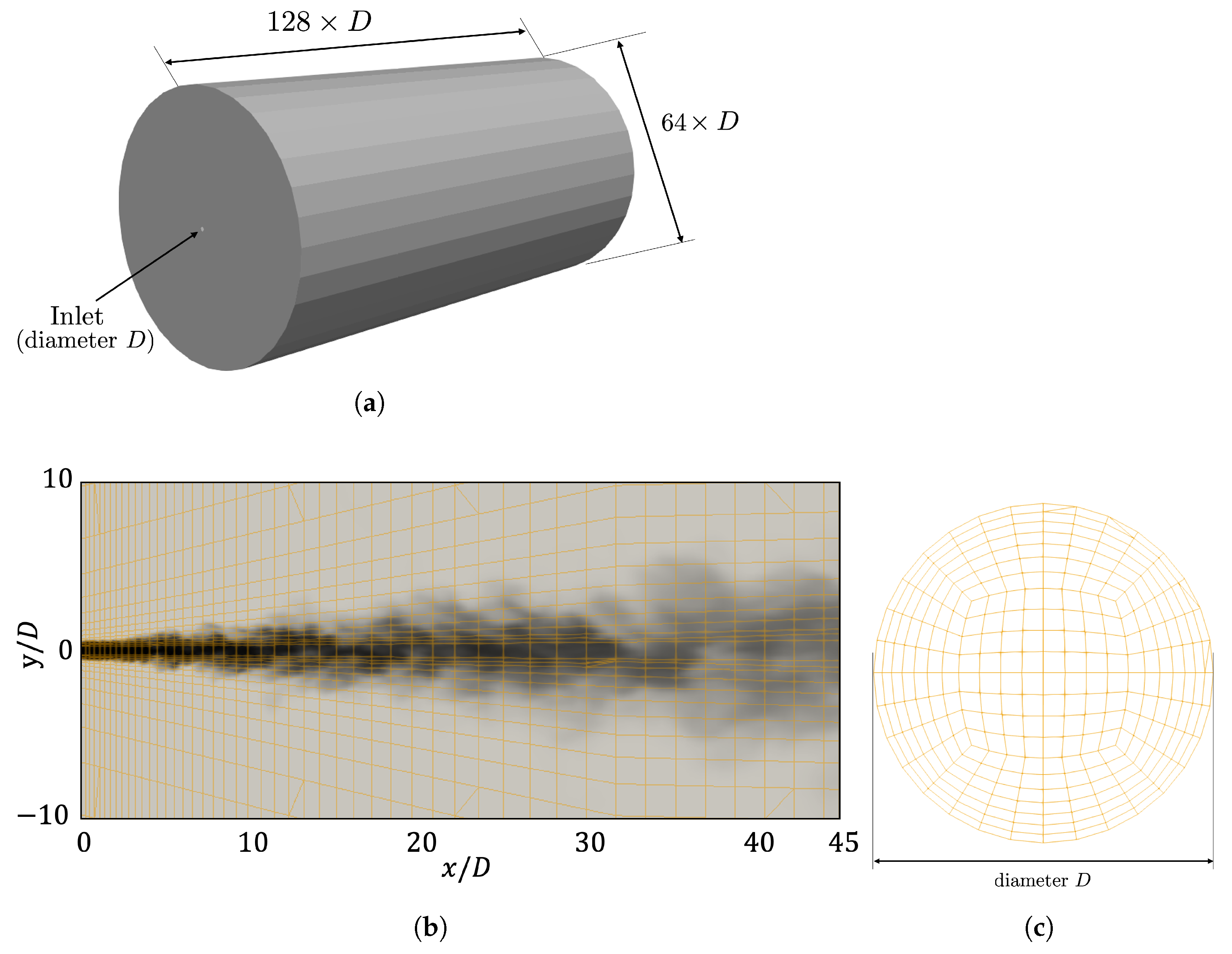
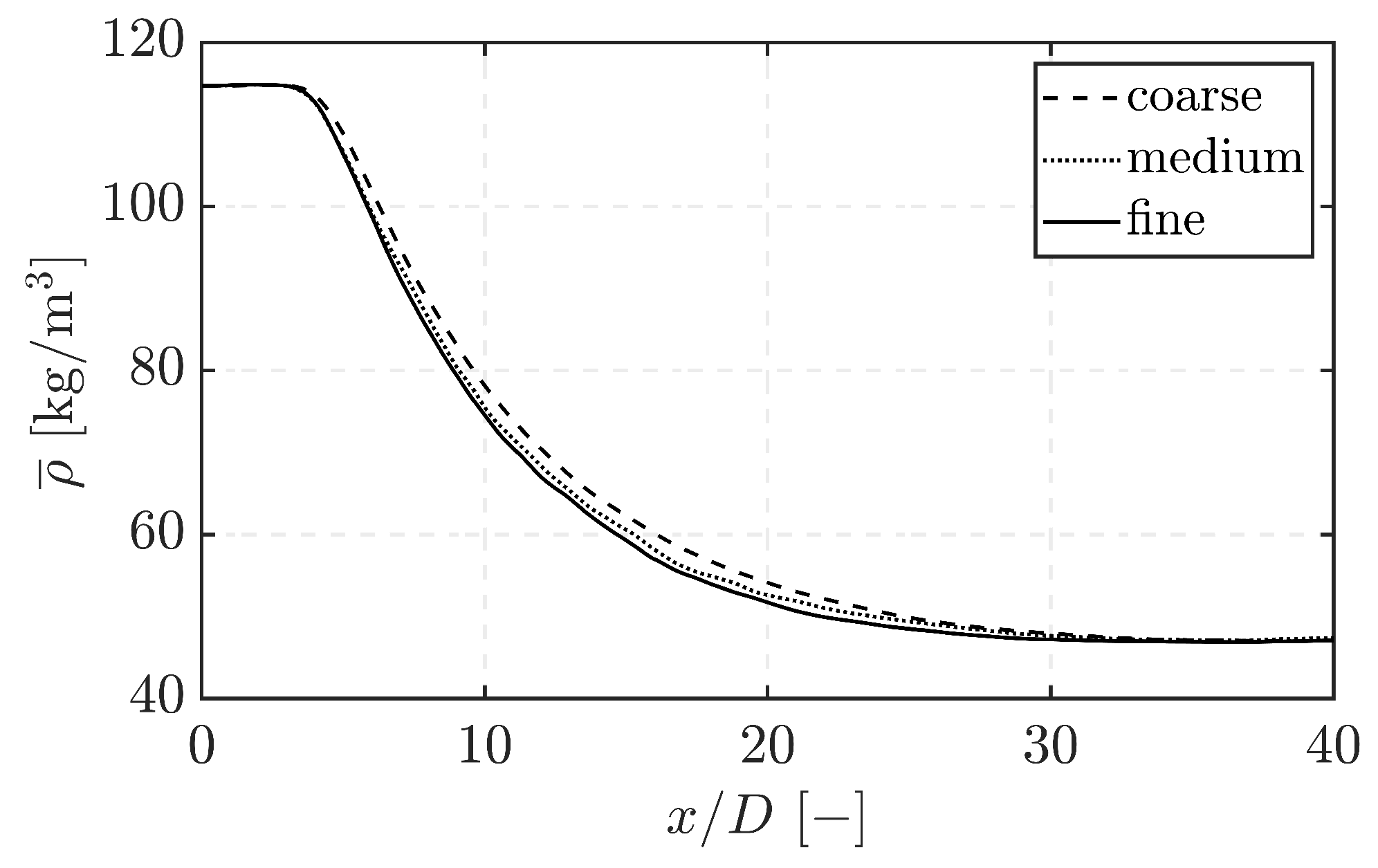


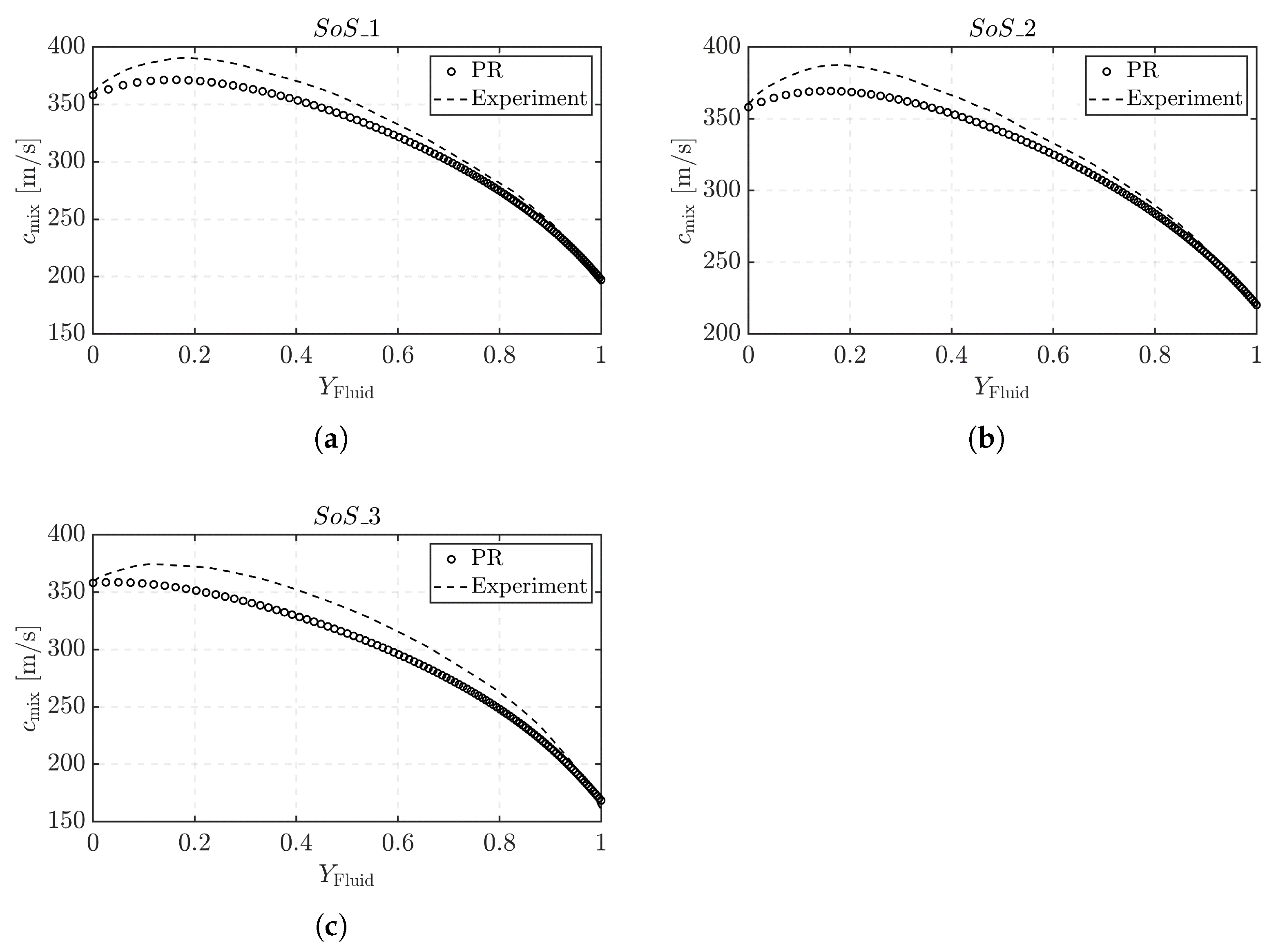
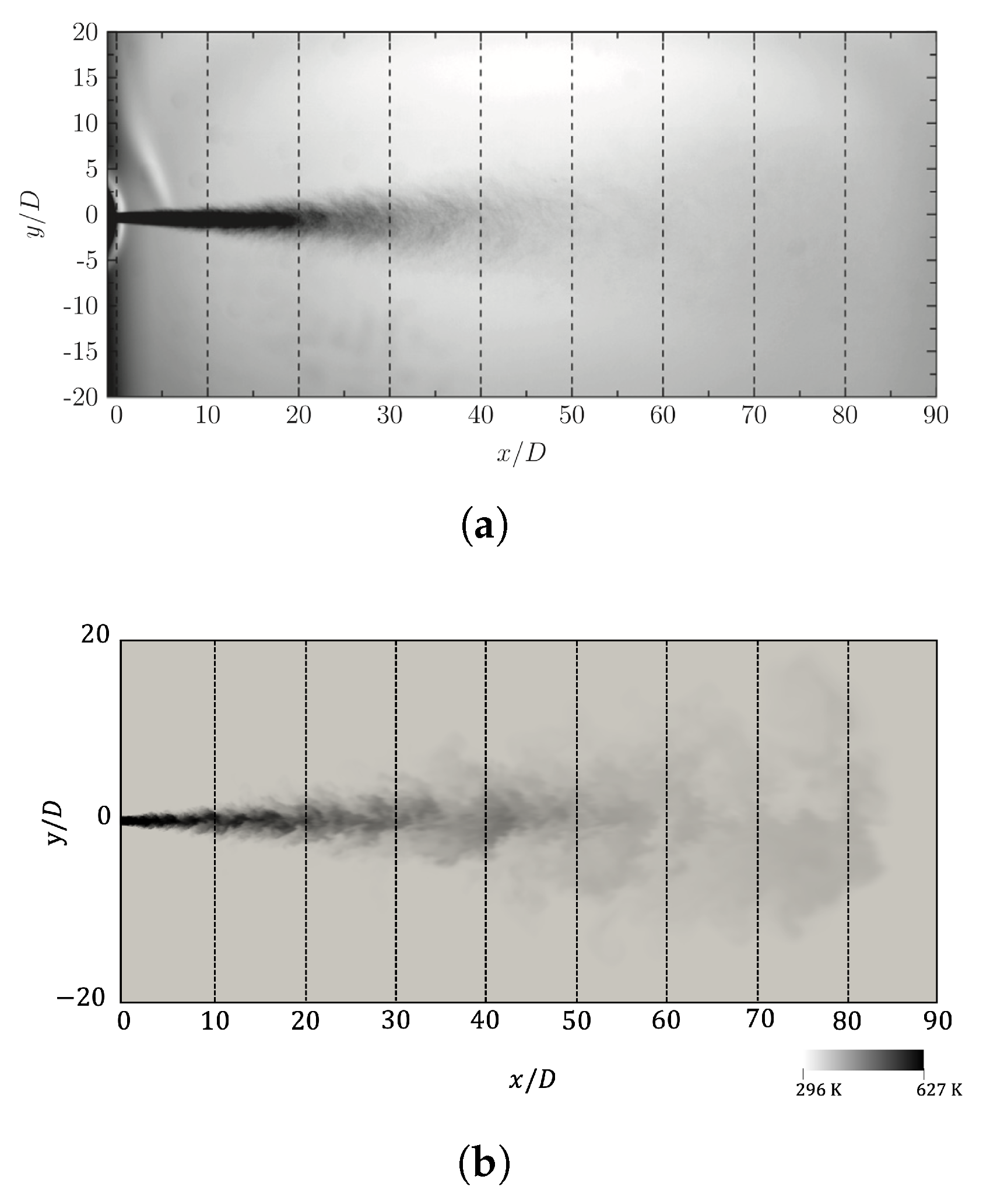
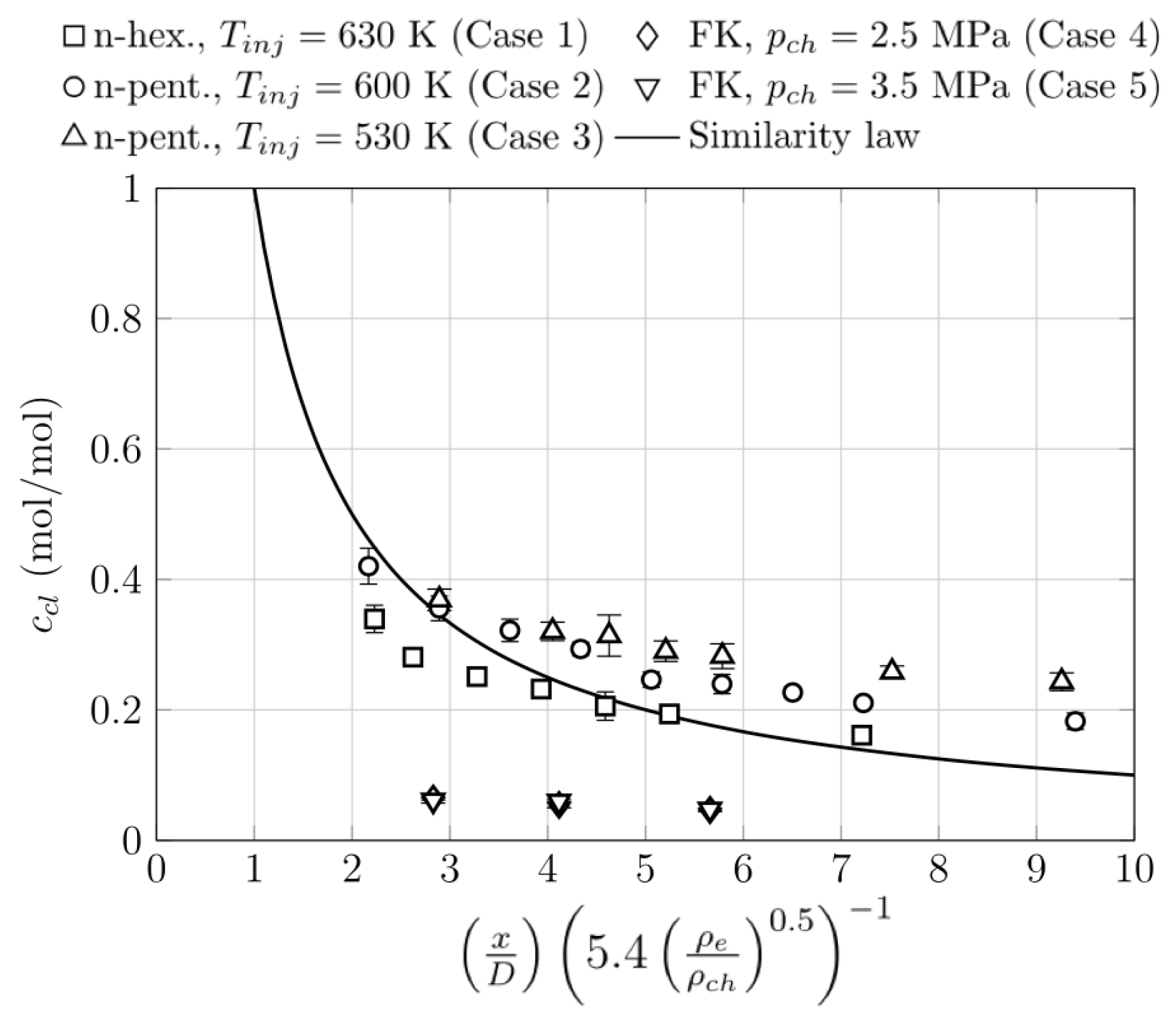
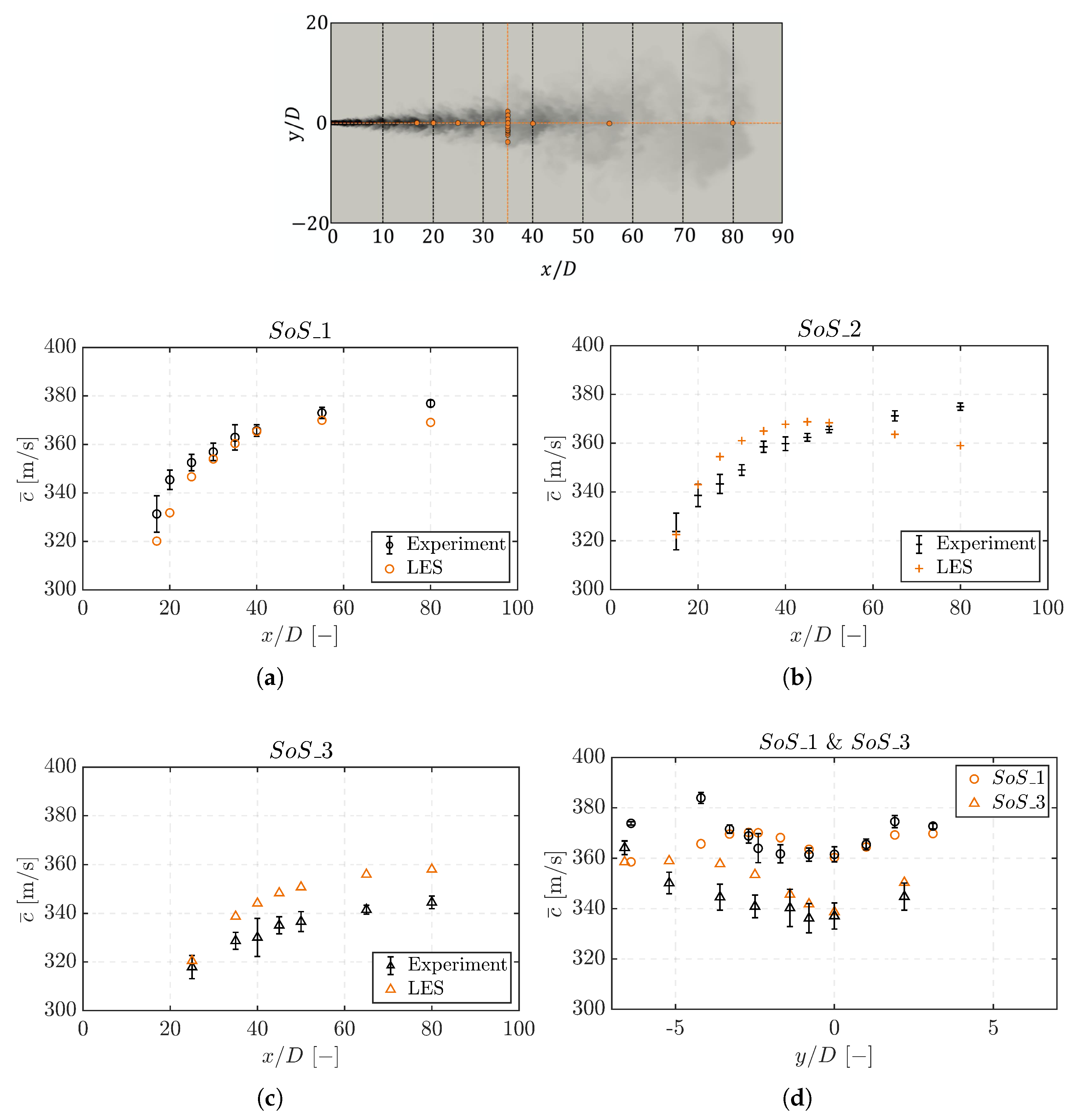
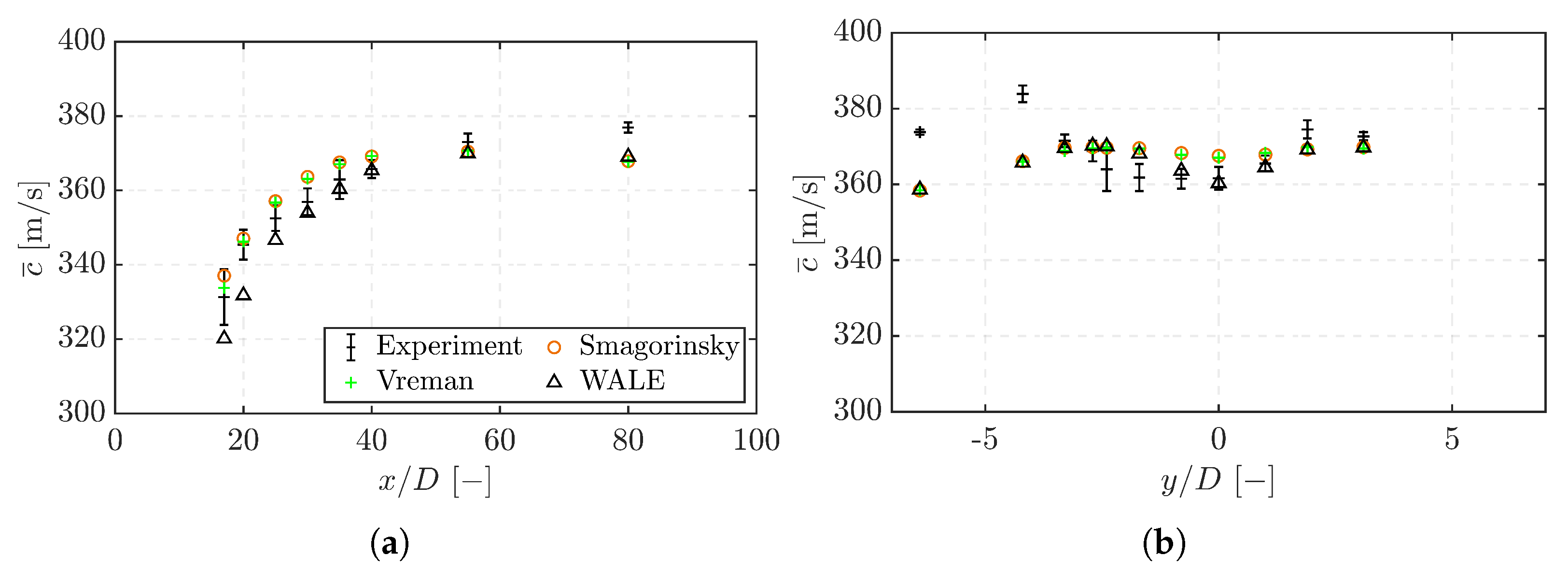
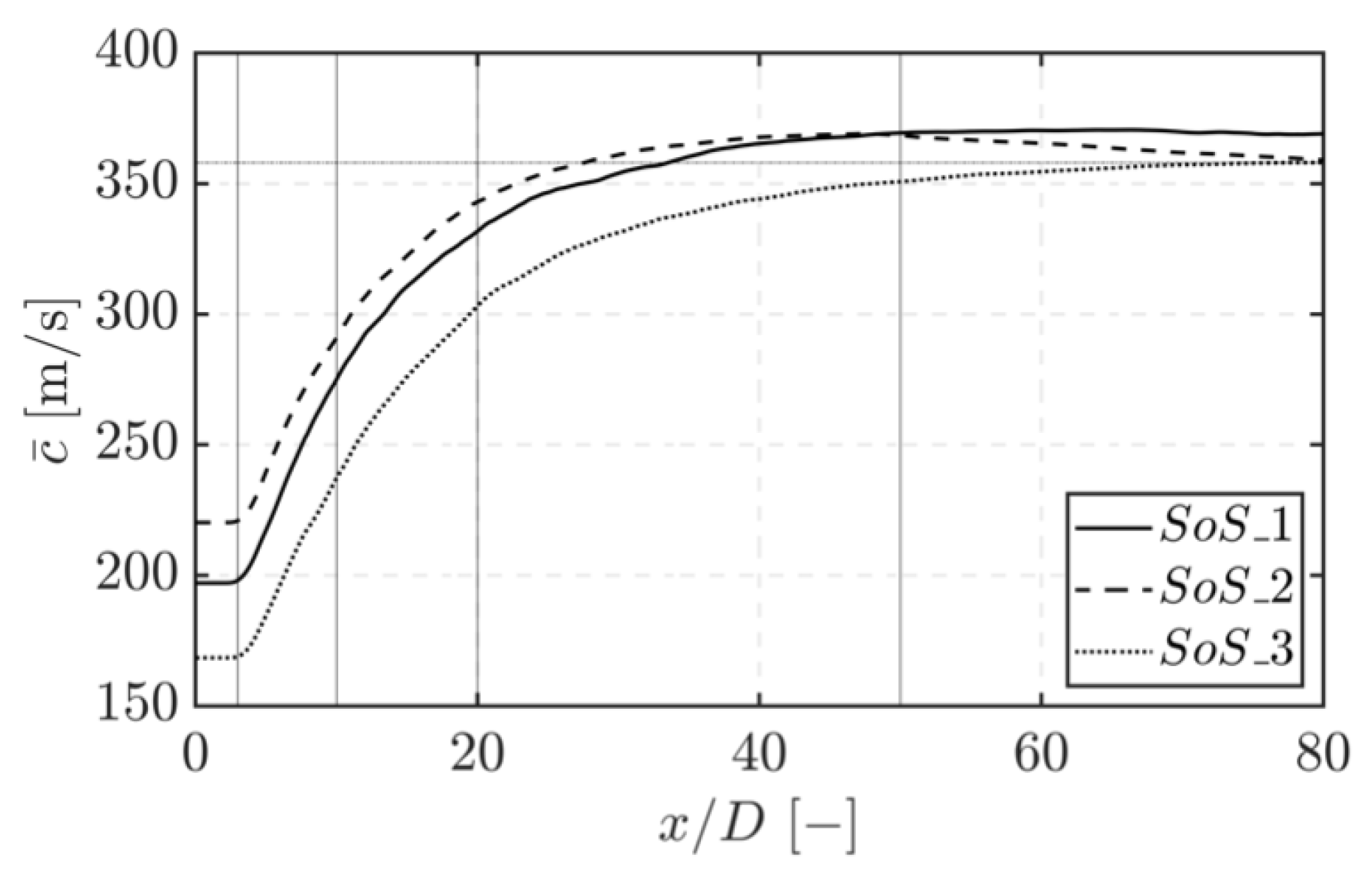
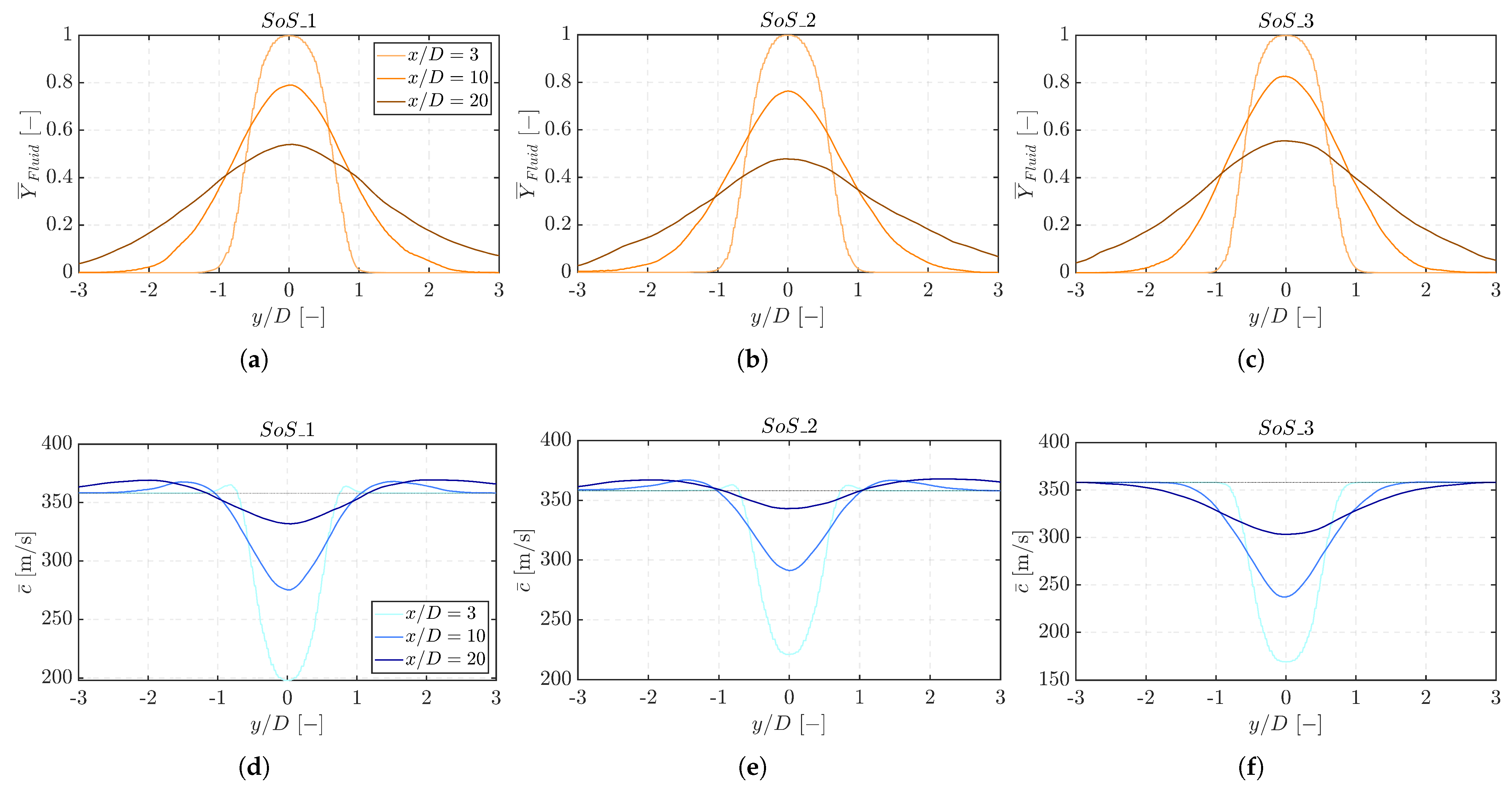
| Case | Fluid | p | ||||
|---|---|---|---|---|---|---|
| _1 | 296 | 627 | 91 | 1.31 × 105 | ||
| _2 | 296 | 597 | 96 | 1.22 × 105 | ||
| _3 | 296 | 526 | 76 | 1.35 × 105 |
| Hexane | 3.04 | 507.82 | |
| Pentane | 3.37 | 469.70 | |
| Nitrogen | 3.40 | 126.19 |
Disclaimer/Publisher’s Note: The statements, opinions and data contained in all publications are solely those of the individual author(s) and contributor(s) and not of MDPI and/or the editor(s). MDPI and/or the editor(s) disclaim responsibility for any injury to people or property resulting from any ideas, methods, instructions or products referred to in the content. |
© 2023 by the authors. Licensee MDPI, Basel, Switzerland. This article is an open access article distributed under the terms and conditions of the Creative Commons Attribution (CC BY) license (https://creativecommons.org/licenses/by/4.0/).
Share and Cite
Begemann, A.; Trummler, T.; Doehring, A.; Pfitzner, M.; Klein, M. Assessment of the Thermodynamic and Numerical Modeling of LES of Multi-Component Jet Mixing at High Pressure. Energies 2023, 16, 2113. https://doi.org/10.3390/en16052113
Begemann A, Trummler T, Doehring A, Pfitzner M, Klein M. Assessment of the Thermodynamic and Numerical Modeling of LES of Multi-Component Jet Mixing at High Pressure. Energies. 2023; 16(5):2113. https://doi.org/10.3390/en16052113
Chicago/Turabian StyleBegemann, Alexander, Theresa Trummler, Alexander Doehring, Michael Pfitzner, and Markus Klein. 2023. "Assessment of the Thermodynamic and Numerical Modeling of LES of Multi-Component Jet Mixing at High Pressure" Energies 16, no. 5: 2113. https://doi.org/10.3390/en16052113
APA StyleBegemann, A., Trummler, T., Doehring, A., Pfitzner, M., & Klein, M. (2023). Assessment of the Thermodynamic and Numerical Modeling of LES of Multi-Component Jet Mixing at High Pressure. Energies, 16(5), 2113. https://doi.org/10.3390/en16052113









